Keywords
|
| Handover algorithm; LTE; Multimedia service; Performance; QOS parameters |
INTRODUCTION
|
OVERVIEW:
|
| Long Term Evolution (LTE) was developed by the 3rd Generation Partnership Project (3GPP). The LTE standard is officially known as “document 3GPP Release 8”. LTE supports peak data rates of 50 Mbps in uplink (UL) and 100 Mbps in downlink (DL), with 20 MHz spectrum on both UL and DL. It supports 300 Mbit/s downlink data rates if we use Multiple Input and Multiple Output [MIMO] antenna technology. LTE supports variable spectrum, which can be used with 1.25, 2.5, 5, 10, 15 and 20 MHz. A cell can cover up to 100 km area [1] with slight degradation after 30 km and reach over 200 users per cell (with 5 MHz spectrum). The major features of LTE are listed below in Table (1) [2] |
ARCHITECTURE:
|
| The main components of LTE with the evolved –universal terrestrial radio access network (E-UTRAN) are evolved NodeB (eNB), Mobility management entity (MME), S1and X2 interfaces. The e-NB which provides the E-UTRAN user and control plane extinction to User Equipment (UE) [2].It also consist of S1 and X2 are the interfaces. The e-NBs are connected together via X2 interface which provides function for user plane and control plane. The S1 is also interface between eNB and mobility management entity (MME) and serving gateway(S-GW).The following Fig (1) shows the LTE architecture with E-UTRAN. |
| • The e-NB distinct functions are Radio resource management, Radio bearer and admission control, routing the data of user plane to the serving gateway(S-GW). |
| • The MME distinct functions are Authentication, UE reach ability in idle mode, tracking of area list, paging message distribution to e-NBs. |
| • The S1 interface distinct functions are Security and roaming, UE identification and capability, Paging. |
| • The X2 interface distinct functions are guaranteed delivery of control plane, Non-guaranteed delivery of user plane. |
| The System Architecture Evolution (SAE) provides the service in packet switched domain and it is the integral part of the LTE architecture. Since SAE offered the enhancement of Packet Switched domain rather than circuit switched domain it provides higher data rates, low latency. By this it ensured that Quality-Of-Service (QOS) is provided for LTE users. [2] |
RELATED WORK
|
| In cellular telecommunications, the term handover or handoff refers to the process of transferring an ongoing call or data session from one channel connected to the core network to another channel. [3] The basic Handover procedure is as shown in Fig (2).Although handover allows one to maintain continuous connection, it also involves a lot of overhead and causes delay for packets to be delivered to the destination UE. There are two types of handovers based on the when the connection to new cell is established. They are |
| • Hard Handovers |
| • Soft Handovers |
Hard Handover
|
| In hard handover, the connection to the target cell is established after the connection to the source cell is broken. Hence this handover is also called the "break-before-make" handover. |
Soft Handover
|
| In soft handover, the connection to the target cell is established before the connection to the source cell is broken. Hence this handover is also called the "make-before-break" handover. |
HANDOVER PROCEDURE IN LTE:
|
| The Handover procedure in LTE is completely Hard Handover i.e. the connection to the target cell is established after the connection to the source cell is broken. Handovers may be classified by the target system, frequency or by the method they are performed. Intra LTE handovers include transitions to the same or different carrier frequency inside an LTE system. [3][4] |
| S1 and X2 handover procedures are the two hard handover procedures as described in Fig (3). These can further be classified to following cases: [5] |
| Intra eNodeB handover refers to a case where the source and target cell reside in the same eNB. In this case no X2 procedure is required for the handover. |
| Inter eNodeB handover depicts a situation where the two target cells are located in two different eNBs. This case assumes that MME will not change as a result of the handover. S-GW may or may not be relocated. X2 or S1 handover process needs to be initiated. |
| Inter eNodeB handover with MME change. X2 handover process can’t handle MME relocation, so S1 procedure must be used instead. |
| The parameters that will affect the Handover decision in LTE are: |
| • Received strength of the signal |
| • Current load of the network |
| • Distance from eNB to UE |
| • Value of threshold calculated between source and target eNBs |
| • Speed of UE etc. |
HANDOVER ALGORITHMS IN LTE:
|
| There are many well known algorithms [6] to carry out the Handover from Source cell to Target cell, some of them are: |
| 1) LTE Hard Handover Algorithm [7] |
| 2) Received Signal Strength based TTT Window Algorithm [8] |
| 3) Integrator Handover Algorithm [7] |
| 4) LTE Hard Handover Algorithm with Average RSRP Constraint [6] |
| In this paper we provide a brief description of LTE Hard Handover Algorithm [7] and LTE Hard Handover Algorithm with Average Received Signal Reference Power (RSRP) Constraint [6] and performance analysis is carried out for above two algorithms considering three performance parameters. This analysis is tested under various scenarios taking QOS requirements of multimedia services under consideration. |
LTE HARD HANDOVER ALGORITHM [7]
|
| This algorithm consists of two variables, handover margin (HOM) and Time to Trigger (TTT) timer. HOM is the difference of signal strength received between neighbouring cells. HOM condition is executed for the defined TTT value. A handover is triggered when the triggering condition (1) and (2) are both satisfied, followed by the handover command. |
| RSRPT > RSRPS (1) |
| HOTrigger >= TTT (2) |
| Where, |
| RSRPT and RSRPs are the received power from the target cell and the serving cell, respectively and HOTrigger timer starts when (1) is satisfied. |
LTE HARD HANDOVER ALGORITHM WITH AVERAGE RSRP CONSTRAINT [6]
|
| The average RSRP of all the UE’s in a particular cell is computed using |
 (1) (1) |
| Where, |
| RSRPs_j(nTm) received power by user j from current cell S at nth period of measurement Tm and N is total number of Tm’s. |
| Next the RSRP of the target cell is compared with the calculated average RSRP of the source cell using (2) |
 (2) (2) |
| This reduces the unnecessary handovers and increases the system throughput. Further the LTE Hard Handover Algorithm [7] conditions are checked and Handover decision is taken. |
PROPOSED WORK
|
| The performance of both the algorithms are compared based on several performance metrics considering the multimedia data such as Audio, Video and prove that LTE Hard Handover Algorithm with Average RSRP Constraint performs better than the LTE Hard Handover Algorithm. The 4 parameters that are used to evaluate the performance are |
| • Throughput of the system – The number of packets correctly received by all mobile nodes in a cell and system throughput is evaluated by considering all the cells. |
| • Average Number of Handovers – The number of Handovers happening in a cell for particular period of time is evaluated. It is evaluated to know the unnecessary handovers happening in a cell and the entire system. |
| • Delay for transmission of multimedia data – The cell delay is evaluated considering the Head-Of-Line (HOL) delay, which is calculated by the time difference of data being pushed from the source UE into the eNB’s buffer and the time when it is released out of buffer to the target UE. |
| • Optimized performance ratio – It is calculated by taking the ratio of system throughput and average number of handovers occurring for particular speed of UE and HOM value. |
| The module diagram of the proposed work is as shown in Fig. (4).Initially the LTE network is created with all the components, defining mobility for User Equipment (UE). Next connection is established between the UEs and corresponding eNB in the cell. Later both the Handover algorithms are tested with the defined performance parameters and the result is collected. |
SIMULATION RESULTS
|
| The performance of the two handover algorithms previously discussed are evaluated, and compared using a JAVA platform computer simulation consisting of a 5 MHz bandwidth and 2 GHz carrier frequency. It contains maximum of 100 users and 5 eNB’s. Users are randomly distributed and each UE will get attached to the nearest eNB. The received signal power by the UE in a cell will depend on the distance from the UE to the corresponding eNB with which it is attached. The mobile users move regularly and the speed are varied according to end user specification. Direction of each UE is randomly chosen between the angles [0,360]. The simulation parameters are as shown in Table (2) |
| The graphs are generated based on the values obtained from the execution of both the algorithms. Simulation time remains same for both the algorithms. Same set of multimedia information is provided as input to both the algorithms for evaluation. Finally based on the result data obtained we can conclude that LTE hard handover algorithm with average RSRP constraint (LHHAARC) performs better compared to LTE hard handover algorithm (LHHA). Sample outputs are as shown in Fig. 5, 6, 7 respectively. |
CONCLUSION AND FUTURE WORK
|
| The performance of the two well known hard handover algorithms is evaluated for transmission of multimedia information (such as audio, video) under various circumstances. The computer simulation is created using JAVA platform. All the LTE components are deployed and the handover implementation is tested. The results are obtained as graphical data and the values are compared to conclude that the LHHAARC performs better than the most basic LHHA. We conclude this by analysing the increase in throughput rate and reduced delay in transmission of multimedia information between mobile nodes. The future work includes collecting and analysing the received signal strength for different cellular structure and considering various other QOS parameters of multimedia information such as Queuing delay, out-of-order delivery of packets and obtaining the fairness index of throughput. |
| |
Tables at a glance
|
 |
 |
| Table 1 |
Table 2 |
|
| |
Figures at a glance
|
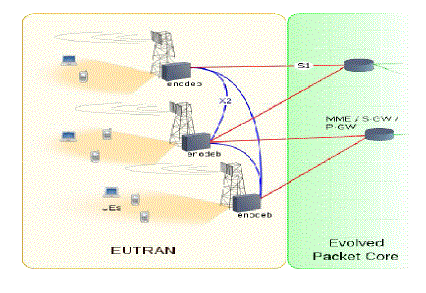 |
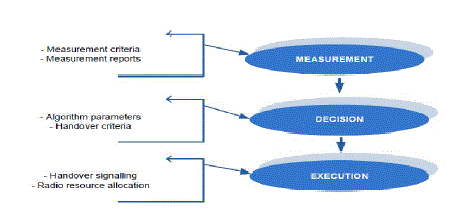 |
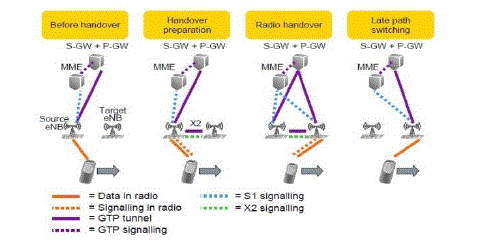 |
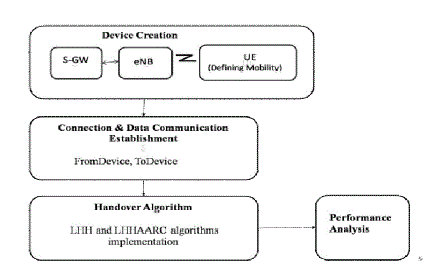 |
| Figure 1 |
Figure 2 |
Figure 3 |
Figure 4 |
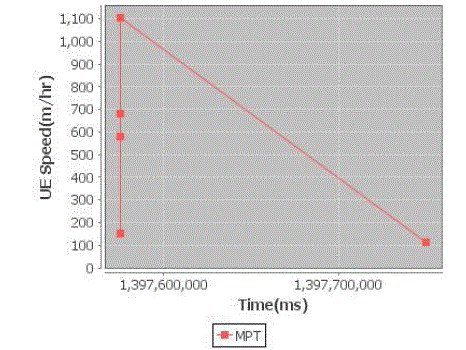 |
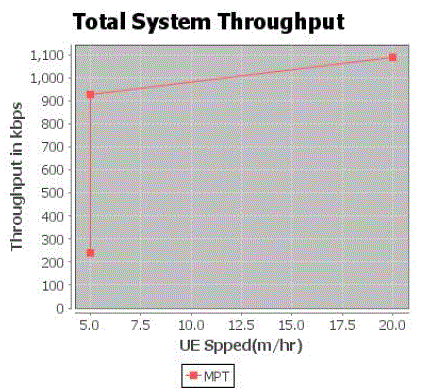 |
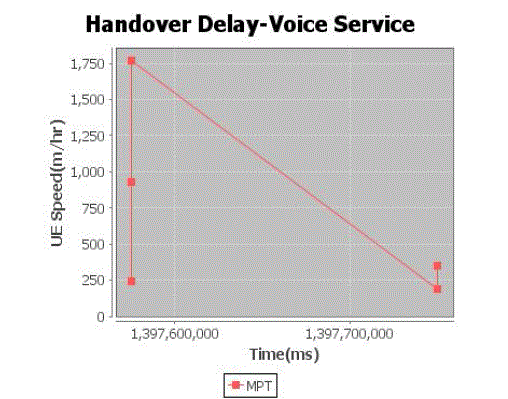 |
| Figure 5 |
Figure 6 |
Figure 7 |
|
| |
References
|
- C. Krapichler, “Lte, hspa and mobile wimax a comparison of technical performance,” in Hot Topics Forum: LTE vsWiMAX and Next Generation Internet, 2007 Institution of Engineering and Technology, pp. 1 –31, 2007.
- Motorola,Inc.,Schaumburg,IL, “Long term evolution (lte): A technical overview,” [Online].Available: http://business.motorola.com/experiencelte/pdf/LTE Technical Overview.pdf
- GPP, "3rd Generation Partnership Project; Technical Specification Group Services and System Aspects; Vocabulary for 3GPP Specifications (Release 8) TR 21.905 V8.4.0," 03-2008.
- GPP, "3rd Generation Partnership Project (3GPP); Technical Specification Group (TSG) RAN 3; Handovers for real-time services from PS domain; (Release 4) TR 25.936 V4.0.1," 12-2001.
- E. Dahlman, S. Parkvall, J. Sköld, and P. Beming, 3G Evolution: HSPA and LTE for Mobile Broadband, 2007.
- Cheng Chung Lin, KumbesanSandrasegaran, Huda AdibahMohdRamli, and RiyajBasukala, “OPTIMIZED PERFORMANCE EVALUATION OF LTE HARD HANDOVER ALGORITHM WITH AVERAGE RSRP CONSTRAINT”, International Journal of Wireless & Mobile Networks (IJWMN) Vol. 3, No. 2, April 2011.
- Z. Naizheng and J. Wigard, "On the Performance of Integrator Handover Algorithm in LTE Networks," in Vehicular Technology Conference, 2008.VTC 2008-Fall.IEEE 68th, pp. 1-5, 2008.
- M. Anas, F. D. Calabrese, P. E. Mogensen, C. Rosa, and K. I. Pedersen, "Performance Evaluation of Received Signal Strength Based Hard Handover for UTRAN LTE," Department of Electronic Systems, Aalborg University, Nokia Networks, 2007.
|